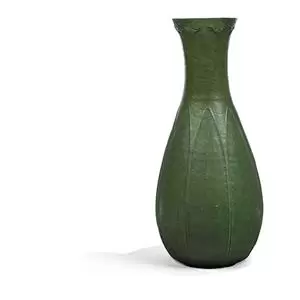What Makes Grueby Great?
I gave a talk at the 2013 American Art Pottery Association’s Convention entitled “1901: The Year That Set the Arts and Crafts Movement in Motion.” My initial research had originally focused on the changes that took place in the workshops of Gustav Stickley, as he and his designers Henry Wilkinson and Lamont Warner successfully made the transition from experimental Art Nouveau forms to what today we consider American Arts and Crafts furniture.
The year 1901 culminated with the publication that October of the first issue of The Craftsman magazine, which did more than any other periodical to publicize the Arts and Crafts philosophy of hand craftsmanship, motifs drawn from nature, and quality materials.
But the adage “we learn best that which we teach” soon came into play, as I began to get a better idea of how William Grueby was regarded in 1901. When George Clingman, who first distributed Gustav Stickley’s furniture under the Tobey Furniture Company name, wrote the introduction to their first furniture catalog, he did not consider Gustav Stickley even worthy of a mention. Instead, he applauded “the celebrated Grueby tile” set into the tops of Stickley’s tabourets, pointing out their “rich green, a superb blue, and a vivid orange” glazes.

Grueby Faience Company floor vase – matte green glazed ceramic. Photo Courtesy of Toomey & Co Auctioneers.
But William Grueby was not just one of the first potters to transition from traditional art pottery to Arts and Crafts pottery, he was also the best. The matte green glaze he developed in combination with their forms derived from nature were soon imitated by a host of competitors. As author David Rago wrote, “a good piece of their work looks more harvested than potted.”
While Rago also estimates than 90% of the Grueby pieces were finished with a green glaze, it remains their most coveted, in part because Grueby continued to experiment with different shades and textures of their green glaze formula.
The favorite decoration at Grueby appears to have been the heavy pointed leaves stretching toward the top of the piece. The higher the relief, the higher the value. Leaves that end with a distinct curl or that display tooled edges are more coveted by collectors than those which appear somewhat ‘flat’ in appearance.
Among the rarest of all that Grueby produced during the first decade of the century were those vases and bowls decorated with a second color, as in the yellow buds of a flower. Second colors of glazes, especially those intended to cover a small, specific area, were difficult to control. Advanced collectors will often judge a piece not only by the presence of a second color, but by how well it remained where the designer had intended during the firing process.
The combination of heavy materials, perfect proportions, restrained yet elegant natural decorations, and a beautiful matte green glaze set Grueby apart from the others in 1901, and continues to do so today.
Books have been and continue to be written about Grueby Pottery and the subtle variations that distinguish an outstanding example from one that merely takes your breath away. Before investing heavily — or selling an example you have found — it is always wise to do your research first, both online and in print.
Good Luck!
Bruce Johnson
Middle Photos: Courtesy of Toomey & Co Auctioneers
Bottom Photo: Courtesy of http://www.Daltons.com.

